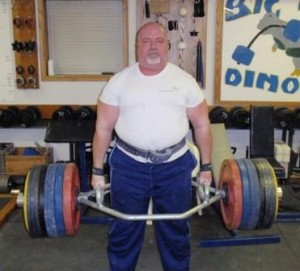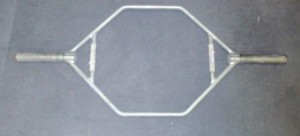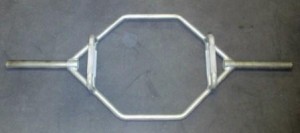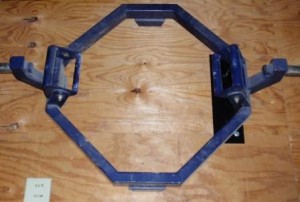Trap Bar Training
by Al Myers

Dino Gym member Chuck Cookson set a new Dino Gym Record in the High Trap Bar Deadlift this week, with a lift of 800 pounds.
The Trap Bar Deadlift has been contested in the USAWA since 1996. I think this is one piece of equipment that every gym should have. The original Trap Bar was the Gerard Trap Bar developed by Al Gerard, a powerlifter from North Carolina, over 20 years ago. Since then several other companies have developed Trap Bars that are very similar, but with minor design changes, getting around the original patent held by Al Gerard. For those not familiar with a Trap Bar, it is an apparatus that contains a frame around the lifter, and has parallel handles located at the lifter’s side for gripping.
Trap Bar training is beneficial and supplemental to deadlift training for several reasons. First of all, it gives a “different line of pull” than deadlifting with a straight bar. By having your arms to your sides, the hips and legs are engaged much more than a bar deadlift, with less demands being placed on the lower back. It is easier to maintain good lifting technique in keeping the shoulders up and the back curved (instead of rounded). More weight can be lifted with the Trap Bar than a straight bar, unless you are a very experienced deadlifter. The grip is easier to maintain. Also, unlike a traditional deadlift where bad technique can lead to “hitching”, it is impossible to “hitch” a Trap Bar Deadlift. I have in the past trained young kids in weight training during the summer, and I always include the Trap Bar Deadlift as one of their key exercises. It is very safe for young kids to do as long as you limit the maximum you allow them to lift. I have a rule that I only allow them to lift up to 150% of their maximum squat set with the Trap Bar. So if they want to improve their Trap Bar Deadlift – they better be improving their squat! I once started training a young girl on the Trap Bar Deadlift, and immediately she complained about the “rough knurling” on the handles. Well, at the end of the week when I was reviewing the kid’s training logs, I noticed she had written the name of this lift as “the Death Grip”. Apparently she misheard me call it “the Dead Lift”, and innocently named it what she thought it should be called!
I am not going into set and rep schemes done with the Trap Bar. There are several good programs that can be done -and in the gym we have tried them all. Describing all of these programs would take more space than I have for this story. We also have a couple of other types of Trap Bars in the gym – one with 3″ elevated handles (only regular handles are allowed in USAWA competition) and one very unique Trap Bar given to the Dino Gym by Shawn Baier, which we call the Baier Trap Bar. It has three adjustable handles with diameters of 1″, 1.5″ and 2″. The height of the pick is 12 inches from the floor (a normal Trap Bar pick is 9″). The use of these High Trap Bars is great for giving variety to Trap Bar Training. We will often add chains to the Trap Bar in order to increase the difficulties at the top of the lift. Chains really help in developing a quicker pull, as less weight is on the bar at the bottom position. I even like to do Trap Bar training in the same workout as straight bar pulls. I find I can do them after regular deadlifting and still able to workout heavy on them.
The Trap Bar Deadlift is going to be a big part of All-Round competition this year. It is in the USAWA National Championships and in the IAWA World Championships. This seems like reason enough to get one for yourself – if you haven’t already. You won’t regret it – and the progress you will make with it will pay off in overall strength gains.


